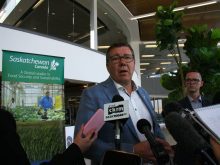PRINCE ALBERT, Sask. – Saskatchewan needs to grow more organic food to lower risks to the environment, increase returns to local producers and return people to rural areas, says a former Saskatchewan MLA.
Lon Borgerson told the Saskatchewan Food Secure Saskatchewan conference in Prince Albert April 22 that expanding organics in the province would help local farmers reap financial rewards, rather than letting those benefits go to organic producers in other parts of the world.
He said food can now travel 2,500 kilometres from field to plate.
Read Also

Storm dynamics and extreme rainfall
Besides moisture, instability and orographic lift, the next biggest factor that contributes to heavy or extreme rainfall is storm dynamics.
“If we could reduce the distance, that’s an important thing to lower energy costs.”
He said most of the food produced in Saskatchewan is exported, while 85 percent of the food eaten in the province is imported.
Borgerson said it’s important to produce food closer to where people live to conserve dwindling energy stocks.
“If you localize food systems, you reduce food miles. It’s one way to address global warming,” he said.
“If we don’t make that choice, it will be forced upon us.”
He said producing food for local markets also means more people stay in rural areas to sustain communities.
Borgerson wrote a report last year on organic agricultural opportunities in Saskatchewan that he presented to the New Democratic Party government last fall before it was defeated.
The report led to the creation of an organic crop production research chair at the University of Saskatchewan and an organic advisory board under the provincial agriculture ministry.
He said governments and other groups can help encourage consumers to buy more Saskatchewan-made food and increase their awareness of the health and nutrition benefits of organic and natural food.
“Cheap food policy translates into cheap, crappy food,” he said.
Borgerson thinks improved commodity prices and the narrowing gap between organic and conventionally produced food make it a good time to substitute local organics for imported organics at the retail level.
He would like to see 10 percent of Saskatchewan farmers in organics by 2015, four times more than the current 1,200 certified producers.
He said 20 percent of the marketplace is already in organics, something he expects will continue to grow.
The biggest organic food consumers are young families between the ages of 18 and 30.
Borgerson said there are opportunities for young people and First Nations to become organic farmers, citing the largely uncultivated tracts of reserve land well suited to organics.
He also saw an opportunity in attracting immigrant farmers, who have much to share about raising food on small tracts of land.
Larry Marshall, an organic grain farmer from Shellbrook, Sask., talked about touring Cuba, which out of necessity has been forced to return to oxen and simpler agricultural practices.
The result is improved health, he said.
In Costa Rica, composting, biological controls and the use of micro-organisms have boosted the health of the soil.
“They realize healthy food comes from healthy soil.”
Marshall said food security hinges not on the quantity but the quality of food.
“If not producing good quality food, you will not have good quality health,” he said.
Cathleen Kneen, chair of Food Secure Canada, cited the need for greater biodiversity, stronger connections between growers and consumers, support for local businesses and a decent living for farmers.
She said food systems are largely controlled by multinational corporations driven to increase value to their shareholders.














